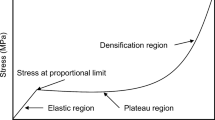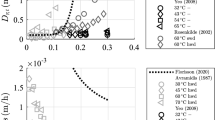Abstract
A finite element method (FEM) numerical model predicting the warping of plywood panels from a description of the intraveneer properties in response to moisture content changes is presented and compared with experimental measurements. Thirteen three-ply plywood panels of 40×40 cm2 (1.9-mm thickness per ply) were manufactured from Douglas fir or from mixed beech and poplar. Maps of the longitudinal and tangential swelling as well as the wood density were established on the veneers before the glueing process. The shape was measured on the panels conditioned first at 17% moisture content (MC), then at the fiber saturation point, in order to calculate the maximum displacements along six profiles (three longitudinal and three tangential) on each panel. These experimental data were compared with the results of simulations based on two models. First, they were compared to a "heterogeneous" model in which all measured veneer properties were used as inputs. In this case the predicted displacements showed a close correlation (R 2=0.74) to the measured ones, but were remarkably underestimated. Second, they were compared to a "homogeneous" model in which the three layers of each panel were only described by their mean density and average swelling coefficients. For this comparison the prediction of the displacements was much less accurate in the longitudinal direction but was still satisfactory in the tangential direction.









Similar content being viewed by others
References
Brauns J, Rocens K (1997) Hygromechanical behaviour of wooden composites. Wood Sci Tech 31:193–204
Du Toit HF, George PL, Laug P, Paté P, Steer D, Vidrascu M (1991) An Introduction to MODULEF. In: MODULEF user guide no 1, INRIA, http://www-rocq.inria.fr/modulef/. Cited 26 September 2001
Grossman PUA (1973) Bowing and cupping due to imbalance in plywood. For Prod J 23:54–58
Guitard D, El Amri F (1987) Modèles prévisionnels de comportement élastique tridimensionnel pour les bois feuillus et pour les bois résineux. Ann Sci For 44:335-358
Guitard D, Seigneurin A (1990) Stabilité dimensionnelle des composites multicouches soumis à un gradient d'humidité: application aux contreplaqués trois plis. Actes du 3ème colloque Sciences et Industries du Bois, Bordeaux, 14–15 May 1990, pp 133–142
Harper BD (1987) The effects of moisture induced swelling upon the shapes of antisymmetric cross-ply laminated. J Compos Mater 21:36–48
Houllier F, Leban JM, Colin F (1995) Linking growth modelling to timber quality assesssment for Norway spruce. For Ecol Manage 74:91–102
Lang EM, Loferski R, Dolan JD (1995) Hygroscopic deformation of wood-based composite panels. For Prod J 45:67–70
Mothe F, Duchanois G, Zannier B, Leban JM (1998) Analyse microdensitométrique appliquée au bois : méthode de traitement des données utilisée à l'Inra-ERQB (programme CERD). Ann Sci For 55:301–313
Mothe F, Chanson B, Thibaut B, Martin G (1990) Etude du retrait en liaison avec la structure. I. Variation radiale des retraits longitudinal et tangentiel sur des placages déroulés de Douglas. Ann Sci For 47:331–344
Norris CB (1942) Techniques of plywood 1942, Laucke, Seattle, WA
Ormarsson S, Dahlblom O, Petersson H (1998) A numerical study of the shape stability of sawn timber subjected to moisture variation. I. Theory. Wood Sci Technol 32:325–334
Ottosen N, Petersson H (1992) Introduction to the finite element method, 1st edn. Prentice Hall, Saddle River, NJ
Pentoney RR (1953) Mechanisms affecting tangential and radial shrinkage. J For Prod Res Soc 3:27–32
Perre P, Turner IW (1999 ) A 3-D version of TransPore: a comprehensive heat and mass transfer computational model for simulating the drying of porous media. Int J Heat Mass Transfer 42:4501–4521
Saint-André L, Leban JM, Houllier F (1995) WinEPIFN 1.0: logiciel pour modéliser et simuler la qualité des bois d'une ressource forestière existante. Modèles pour l'Epicea commun. Pour PC sous Windows, Equipe de Recherches sur la Qualité des Bois, INRA 54280 Champenoux, France, code APP, IDDN FR.001.360012.00R.X.1996.000.00000
Schusland O, McNatt JD (1986) Computer simulation of laminated wood panel warping. For Prod J 36:16–23
Author information
Authors and Affiliations
Corresponding author
Rights and permissions
About this article
Cite this article
Constant, T., Badia, M.A. & Mothe, F. Dimensional stability of Douglas fir and mixed beech–poplar plywood: experimental measurements and simulations. Wood Sci Technol 37, 11–28 (2003). https://doi.org/10.1007/s00226-003-0165-9
Received:
Published:
Issue Date:
DOI: https://doi.org/10.1007/s00226-003-0165-9




